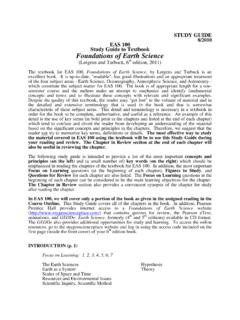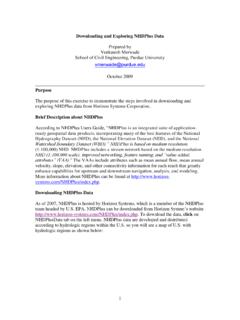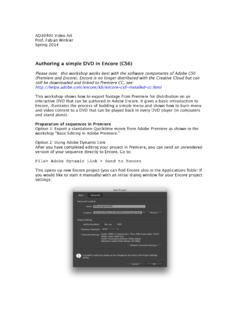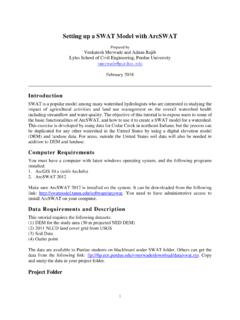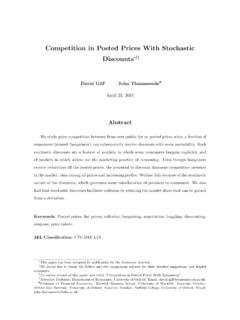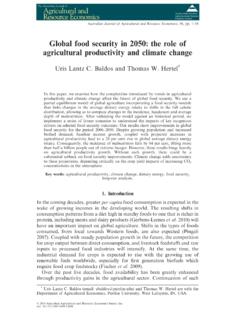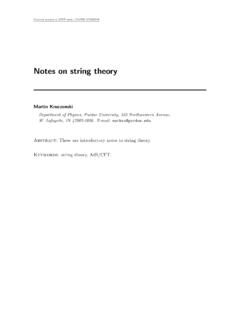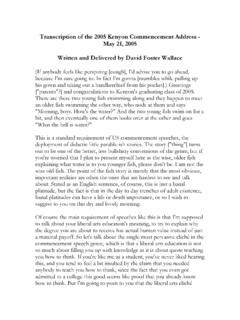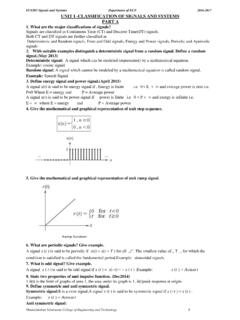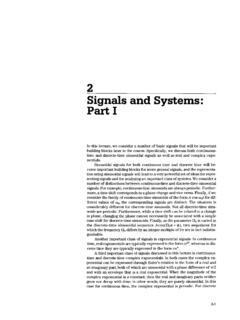Transcription of ECE 301: Signals and Systems Homework Assignment #2
1 ECE 301: Signals and SystemsHomework Assignment #2 Due on September 30, 2015 Professor:Aly El GamalTA:Xianglun Mao1 Aly El GamalECE 301: Signals and Systems Homework Assignment #2 Problem 1 Problem 1 Show that causality for a continuous- time linear system is equivalent to the following statement:For any timet0and any inputx(t) such thatx(t) = 0 fort < t0, the corresponding outputy(t) must alsobe zero fort < : Ifx(t) = 0 fort < t0, theny(t) = 0 fort < t0. To prove that: The system is us consider an arbitrary signalx1(t). Then, let us consider another signalx2(t) which is the same asx1(t) fort < t0. But fort > t0,x2(t)6=x1(t). Since the system is linear,x1(t) x2(t) y1(t) y2(t).Sincex1(t) x2(t) = 0 fort < t0, by our assumptiony1(t) y2(t) = 0 fort < t0. This implies thaty1(t) =y2(t) fort < t0.
2 In other words, the output is not affected by input values fort t0. Therefore, thesystem is : The system is causal. To prove that: Ifx(t) = 0 fort < t0, theny(t) = 0 fort < us assume that the signalx(t) = 0 fort < t0. Then we may expressx(t) asx(t) =x1(t) x2(t), wherex1(t) =x2(t) fort < t0. Since the system is linear, the output tox(t) will bey(t) =y1(t) y2(t). Now,since the system is causal,x1(t) =x2(t) fort < t0implies thaty1(t) =y2(t) fort < t0. Therefore,y(t) = 0fort < El GamalECE 301: Signals and Systems Homework Assignment #2 Problem 2 Problem 2 The initial rest assupmtion corresponds to a zero-valued auxiliary condition being imposed at a time deter-mined in accordance with the input signal . In this problem we show that if the auxiliary condition usedis nonzero or if it is always applied at a fixed time (regardless of the input signal ) the corresponding sys-tem cannot be LTI.
3 Consider a system whose inputx(t) and outputy(t) satisfy the first-order differentialequation:dy(t)dt+ 2y(t) =x(t)(1)(a) Given the auxiliary conditiony(1) = 1, use a counterexample to show that the system is not linear.(b) Given the auxiliary conditiony(1) = 1, use a counterexample to show that the system is not timeinvariant.(c) Given the auxiliary conditiony(1) = 1, show that the system is incrementally linear.(d) Given the auxiliary conditiony(1) = 0, show that the system is linear but not time invariant.(e) Given the auxiliary conditiony(0) +y(4) = 0, show that the system is linear but not time (a) Considerx1(t)S y1(t) andx2(t)S y2(t). We know thaty1(1) =y2(1) = 1. Now consider a thirdinput to the system which isx3(t) =x1(t) +x2(t). Let the corresponding output bey3(t).
4 Now,note thaty3(1) = 16=y1(1) +y2(1). Therefore, the system is not linear. A specific example follows:Consider an input signalx1(t) =e2tu(t), the corresponding output fort >0 isy1(t) =14e2t+Ae the fact thaty1(1) = 1, we get fort >0y1(t) =14e2t+ (1 e4)e 2(t 1)Now, consider a second signalx2(t) = 0. Then, the corresponding output isy2(t) =Be 2tfort >0. Using the fact thaty2(1) = 1, we get fort >0y2(t) =e 2(t 1).Now consider a third signalx3(t) =x1(t) +x2(t) =x1(t). Note that the output we get still bey3(t) =y1(t) fort >0. Clearly,y3(t)6=y1(t) +y2(t) fort >0. Therefore, the system is not linear.(b) Again consider an input signalx1(t) =e2tu(t). We know that the corresponding output fort >0 withy1(1) = 1 isy1(t) =14e2t+ (1 e4)e 2(t 1).Now, consider an input signal of the formx2(t) =x1(t T) =e2(t T)u(t T).
5 The output fort > Tisy2(t) =14e2(t T)+Ae 2 continued on next page..3 Aly El GamalECE 301: Signals and Systems Homework Assignment #2 Problem 2 (continued)Using the fact thaty2(1) = 1 and also assuming thatT <1, we get fort > Ty2(t) =14e2(t T)+ (1 14e2(1 T))e note thaty2(t)6=y1(t T) fort > T. Therefore, the system is not time invariant.(c) In order to show that system is incrementally linear with the auxiliary condition specified asy(1) = 1,we need to first show that the system is linear with the axiliary condition specified asy(1) = an input-output pairx1(t) andy1(t), we may use (1) and the initial rest condition to writedy1(t)dt+ 2y1(t) =x1(t), y1(1) = 0 For an input-output pairx2(t) andy2(t), we may use (1) and the initial rest condition to writedy2(t)dt+ 2y2(t) =x2(t), y2(1) = 0 Scaling the first equation by and second equation by and summing, we getddt{ y1(t) + y2(t)}+ 2{ y1(t) + y2(t))}= x1(t) + x2(t)andy3(1) =y1(1) +y2(1) = 0By inspection, it is clear that the output isy3(t) = y1(t) + y2(t) when the input isx3(t) = x1(t) + x2(t).
6 Furthermore,y3(1) = 0 =y1(1) +y2(1). Therefore, the system is , the overall system may be treated as the cascade of a linear system with an adder whichadds the response of the system to the auxiliary conditions alone.(d) In the previous part, we showed that the system is linear wheny(1) = 0. In order to show that thesystem is not time invariant, consider an input of the formx1(t) =e2tu(t). From part (a), we knowthat the corresponding output will bey1(t) =14e2t+Ae the fact thaty1(1) = 0, we get fort >0y1(t) =14e2t 14e 2(t 2)Now consider an input of the formx2(t) =x1(t 1/2). Note thaty2(1) = 0. Clearly,y2(1)6=y1(1 1/2) = (1/4)(e e3). Therefore,y2(t)6=y1(t 1/2) for allt. This implies that the system isnot time invariant.(e) A proof which is similar to the proof for linearity used in part (c) may be used here.
7 We may showthat the system is not time invariant by using the method outlined in part (d).To prove the linearity, we may use the similar method outlined in part (c). For an input-output pairx1(t) andy1(t), we may use (1) and the initial rest condition to writedy1(t)dt+ 2y1(t) =x1(t), y1(0) +y1(4) = 0 For an input-output pairx2(t) andy2(t), we may use (1) and the initial rest condition to writedy2(t)dt+ 2y2(t) =x2(t), y2(0) +y2(4) = 0 Problem 2 continued on next page..4 Aly El GamalECE 301: Signals and Systems Homework Assignment #2 Problem 2 (continued)Scaling the first equation by and second equation by and summing, we getddt{ y1(t) + y2(t)}+ 2{ y1(t) + y2(t))}= x1(t) + x2(t)andy3(0) +y3(4) =y1(0) +y1(4) +y2(0) +y2(4) = 0By inspection, it is clear that the output isy3(t) = y1(t) + y2(t) when the input isx3(t) = x1(t) + x2(t).
8 Furthermore,y3(0) +y3(4) = 0 =y1(0) +y1(4) +y2(0) +y2(4). Therefore, thesystem is show the system is not time invariant, we again consider an input of the formx1(t) =e2tu(t). Frompart (a), we know that the corresponding output will bey1(t) =14e2t+Ae the fact thaty1(0) +y1(4) = 0, we get fort >0y1(t) =14e2t 14 1 +e81 +e 8e 2tNow, consider an input signal of the formx2(t) =x1(t T) =e2(t T)u(t T). The output fort > T,y2(t) =14e2(t T)+Ae the fact thaty2(0) +y2(4) = 0 and also assuming thatT <1, we get fort > Ty2(t) =14e2(t T) 14 e2(4 T)+e 2T1 +e 8e note thaty2(t)6=y1(t T) fort > T. therefore, The system is not time El GamalECE 301: Signals and Systems Homework Assignment #2 Problem 3 Problem 3 Letx[n] ={1,0 n 90,elsewhereandh[n] ={1,0 n N0,elsewherewhereN 9 is an integer. Determine the value ofN, given thaty[n] =x[n] h[n] andy[4] = 5, y[14] = 0 SolutionThe signaly[n] isy[n] =x[n] h[n] = k= x[k]h[n k]In this case, this summation reduces toy[n] =9 k=0x[k]h[n k] =9 k=0h[n k]From this it is clear thaty[n] is a summation of shifted replicas ofh[n].}}
9 Since the last replica will begin atn= 9 andh[n] is zero forn > N,y[n] is zero forn > N+ 9. Using this and the fact thaty[14] = 0, we mayconclude thatNcanat mostbe 4. Furthermore, sincey[4] = 5, we can conclude thath[n] hasat least5non-zero points. The only value ofNwhich satisfies both these conitions is El GamalECE 301: Signals and Systems Homework Assignment #2 Problem 4 Problem 4 One of the important properties of convolution, in both continuous and discrete time , is the associativityproperty. In this problem, we will check and illustrate this property.(a) Prove the equality[x(t) h(t)] g(t) =x(t) [h(t) g(t)](2)by showing that both sides of (2) equal x( )h( )g(t )d d (b) Consider two LTI Systems with the unit sample responsesh1[n] andh2[n] shown in Figure 1(a). Thesetwo Systems are cascaded as shown in Figure 1(b).
10 Letx[n] =u[n].(i) Computey[n] by first computingw[n] =x[n] h1[n] and then computingy[n] =w[n] h2[n]; thatis,y[n] = [x[n] h1[n]] h2[n](ii) Now findy[n] by first convolvingh1[n] andh2[n] to obtaing[n] =h1[n] h2[n] and then convolvingx[n] withg[n] to obtainy[n] =x[n] (h1[n] h2[n]).The answers to (i) and (ii) should be identical, illustrating the associativity property of discrete -timeconvolution.(c) Consider the cascade of two LTI system as in Figure 1(b), where in this caseh1[n] =sin(8n)andh2[n] =anu[n],|a|<1and where the input isx[n] = [n] a [n 1]Determine the outputy[n]. (Hint: The use of the associative and communicative properties of convo-lution should greatly facilitate the solution.)Figure 1: The discrete - time signalh1(t),h2(t) (a) and the cascaded system (b).Problem 4 continued on next page.
